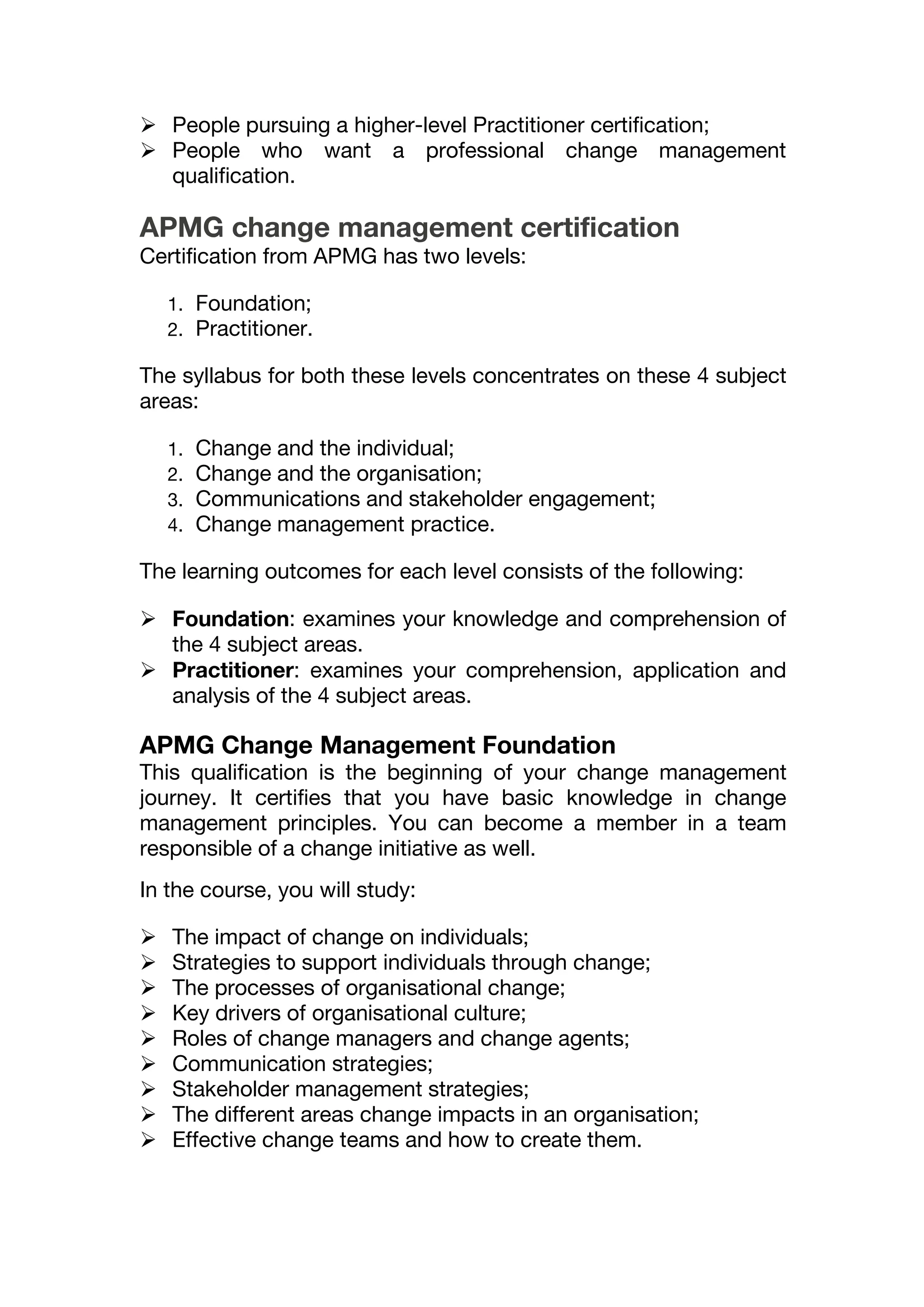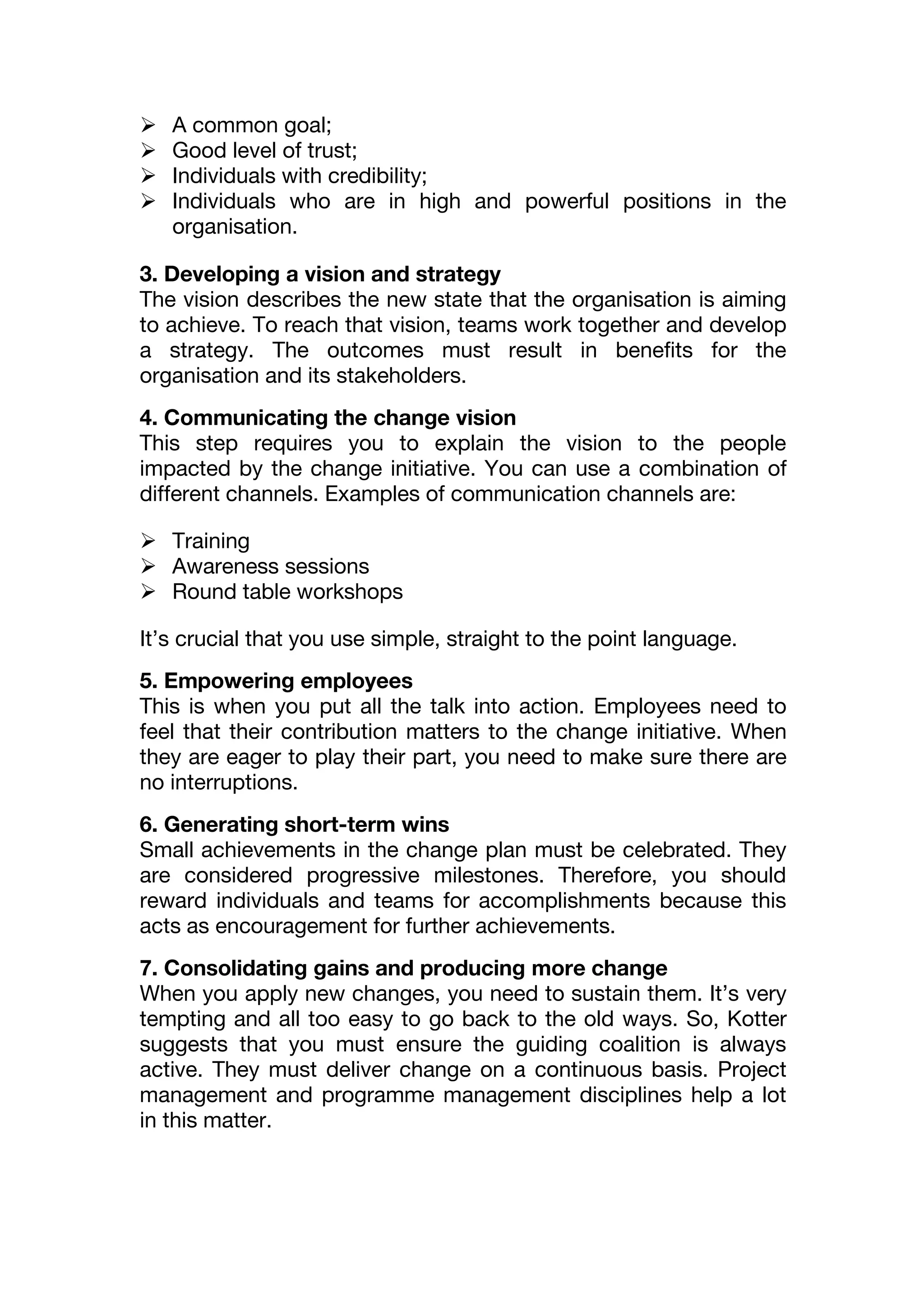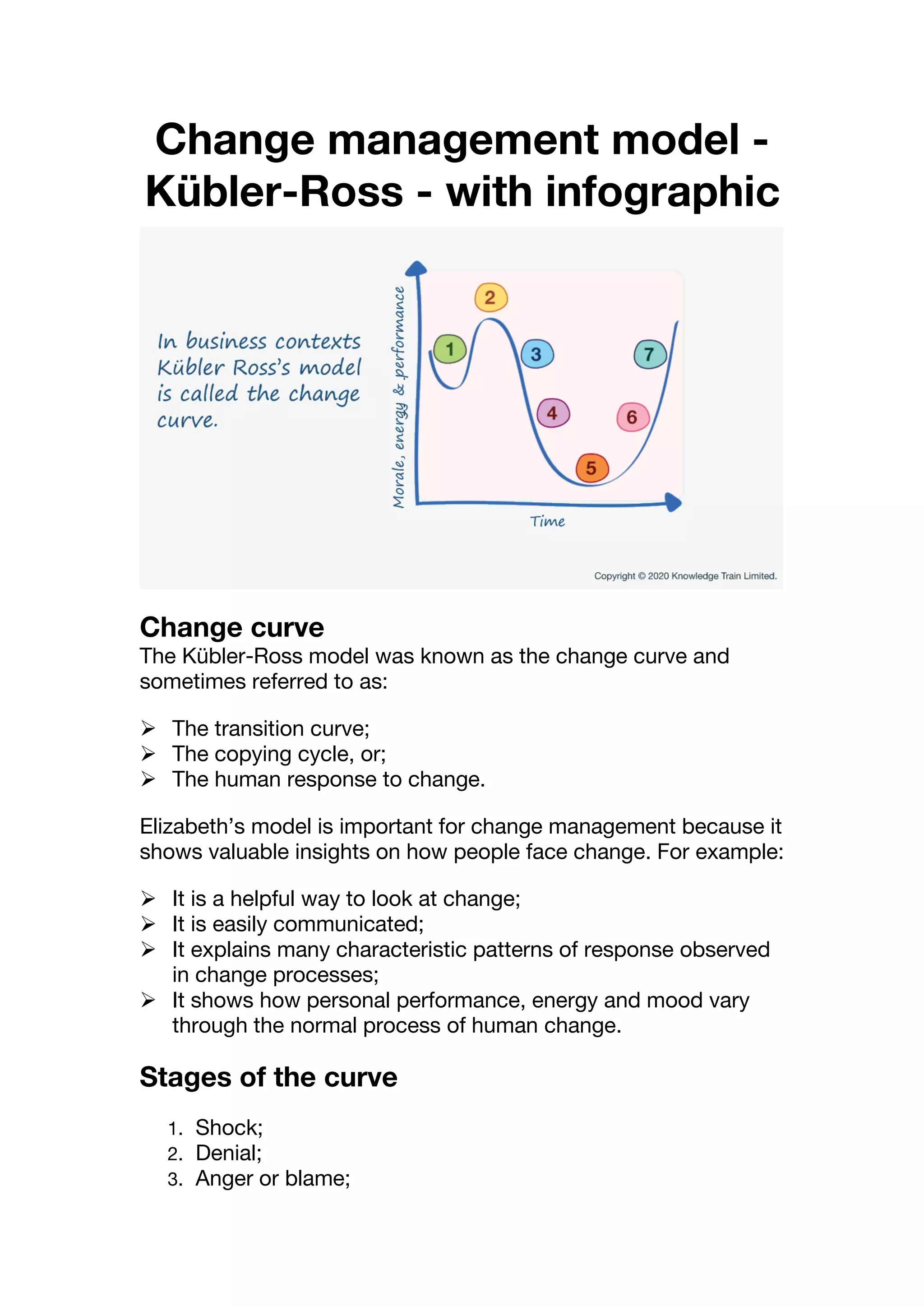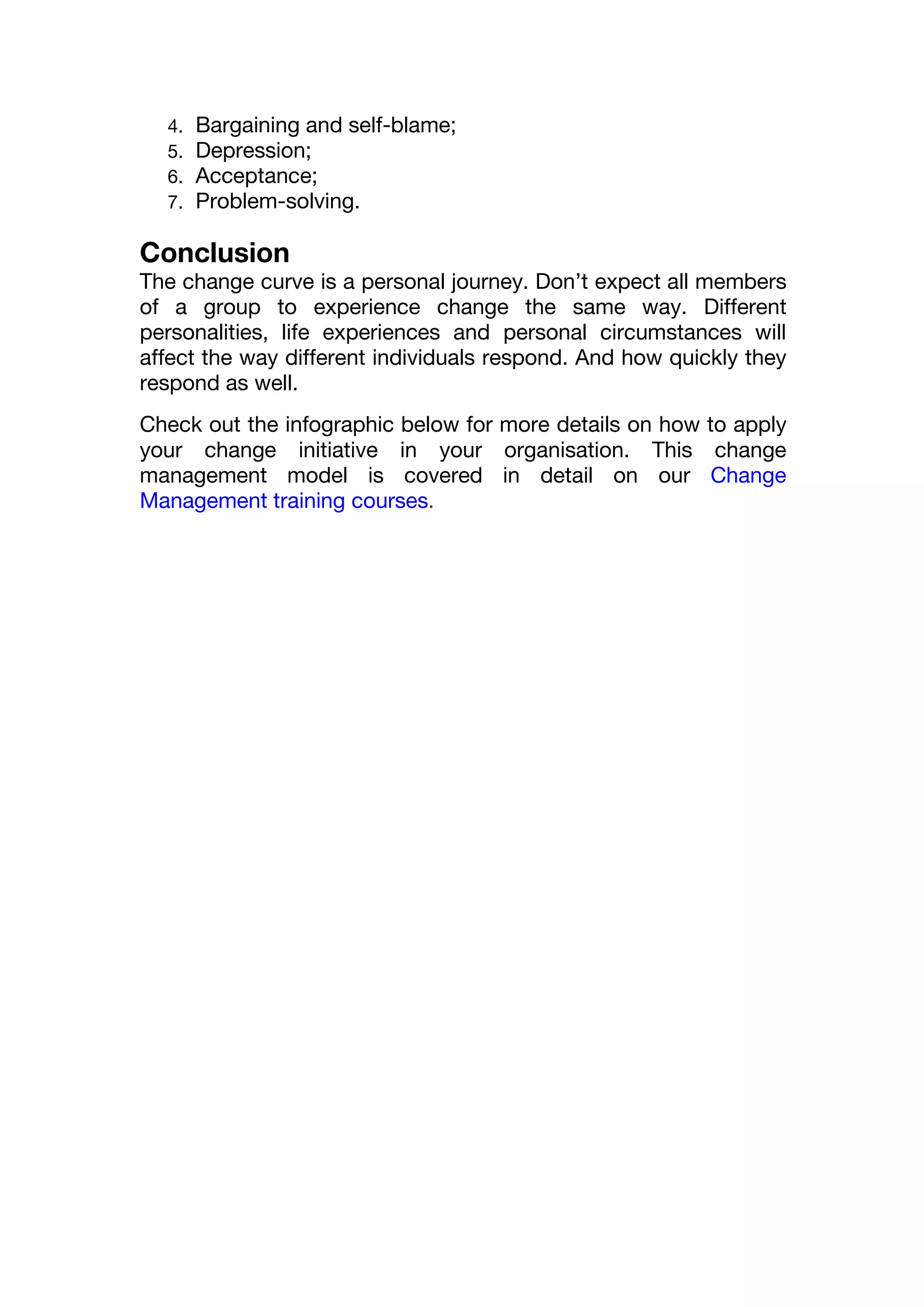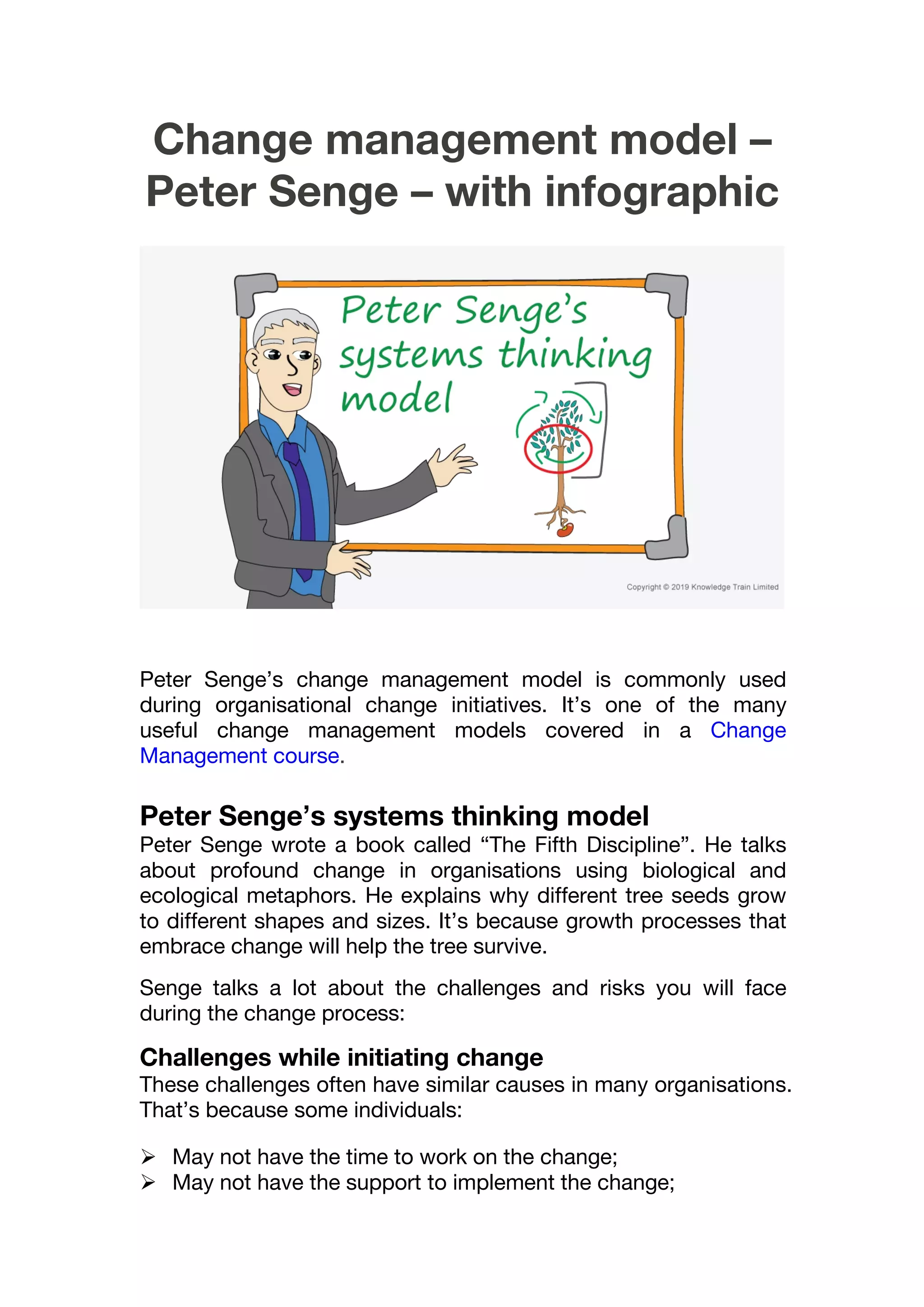The document provides a comprehensive overview of change management, including its definition, models, and the significance of change managers in organizations. It outlines the processes and tools used in change management, such as Lewin's three-stage model and Kotter's eight-step model, and discusses the evolution and importance of formal change management frameworks and certifications. Additionally, it explains the responsibilities and skills required for business change managers and highlights the growing demand for change management roles in today's corporate landscape.

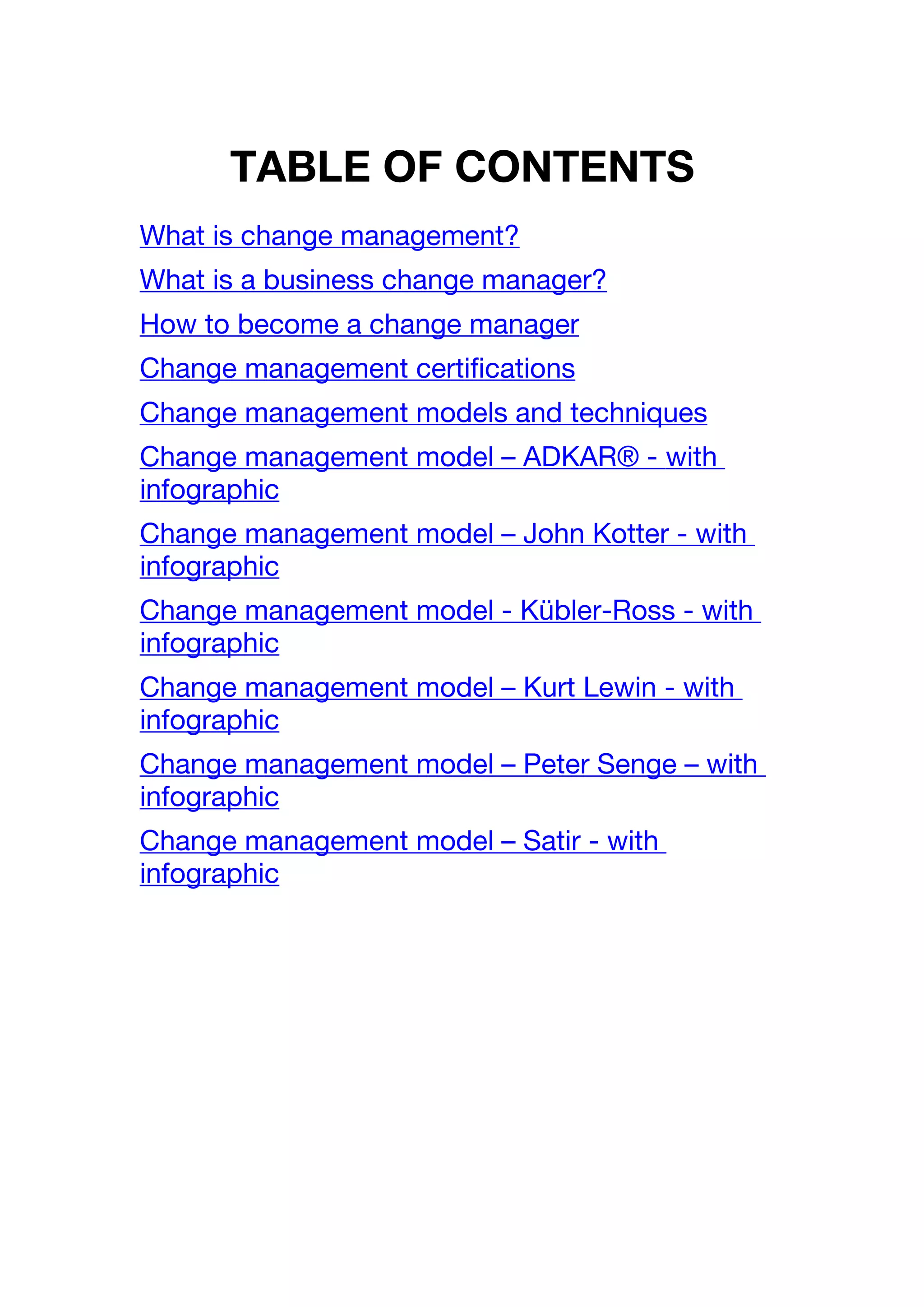
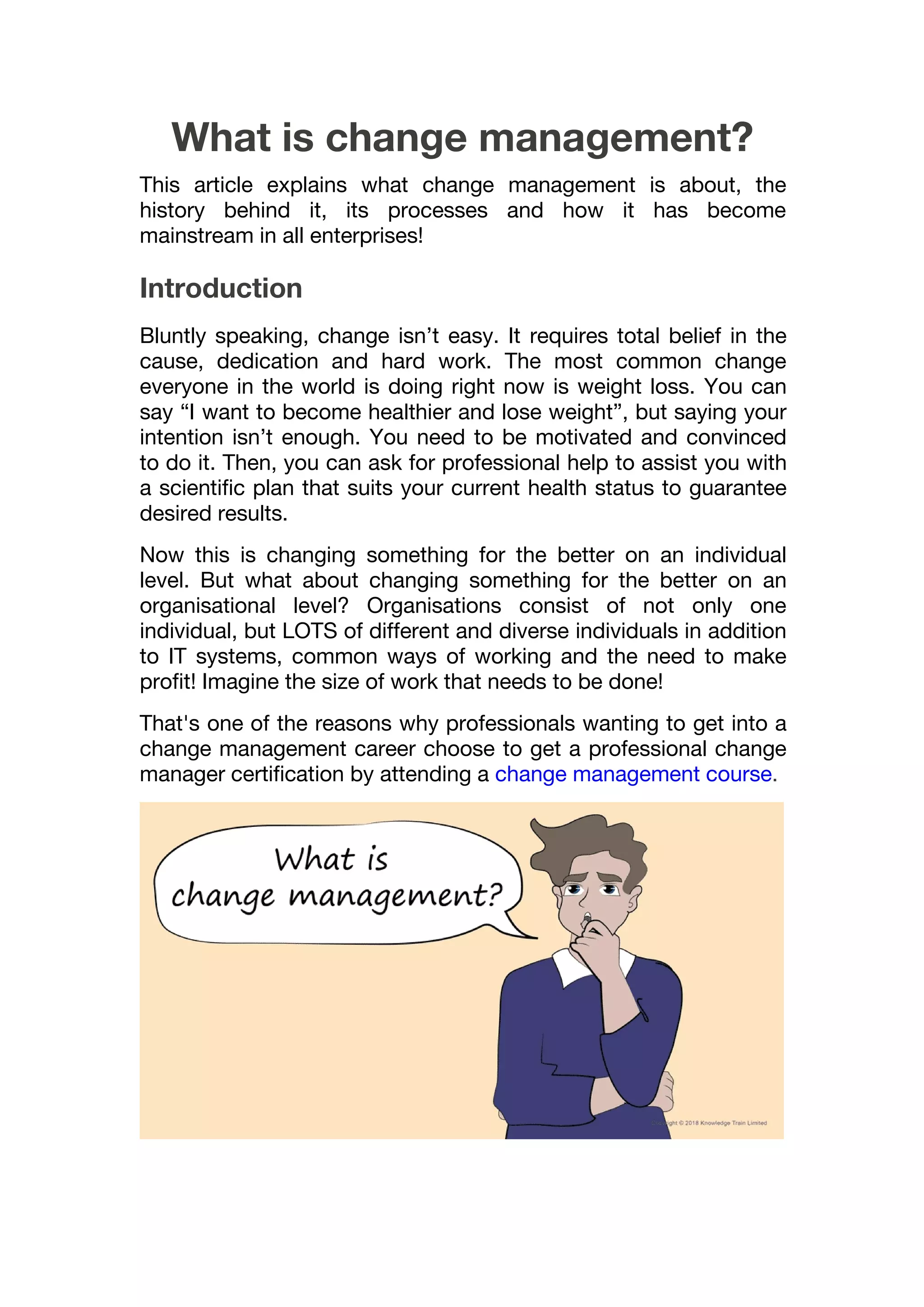
![Definition of change management
Change management is simply defined as a structured approach
to moving an organisation from the current state to the desired
future state.[1].
Change in an organisation can be any minor or major alteration in
internal structure, policies, strategic plans, organisational culture,
IT solutions or marketing/sales approaches. Such change is
normally implemented to achieve an improvement. Organisational
change often causes resistance, which is a natural reaction and
must be taken into consideration.
Applying change in organisations is a hefty task. It is extremely
challenging but rewarding at the same time. It is now a field of
management on its own and is studied as an academic and
professional course in universities, colleges and institutions.
Evolution of change management
Before 1990, understanding change and its effects on human
beings was an ongoing study among thinkers, academics and
psychologists.
However, change became a hot topic in the early 1990s, being
spoken about as a discipline in project meetings and at
boardroom tables. It became mainstream after a couple of](https://image.slidesharecdn.com/changemanagementmodelsebook-210330094747/75/Change-management-models-ebook-4-2048.jpg)
![companies and authors put change on the map through new
processes and school of thought. Some examples are:
General Electric introduced the Change Acceleration Process
as part of its larger improvement program.
Todd Jick, a senior lecturer in Columbia Business School,
introduced the Ten Commandments of Implementing
Change in his famous textbook “Managing Change: Cases and
Concepts”.
Spencer Johnson, author of “Who Moved my Cheese?”,
amuses us with his mouse maze allegory about change and
how to deal with it. [2]
In the year 2000 and onwards, the change discipline became
formalised as another type of management, and official
frameworks started to develop.
In 2005, the Change Management Institution (CMI) was
established in Sydney, Australia. They have authored “The
Effective Change Manager: The Change Management Body of
Knowledge” (CMBoK) and it is widely recognised as one of the
best books in change management.](https://image.slidesharecdn.com/changemanagementmodelsebook-210330094747/75/Change-management-models-ebook-5-2048.jpg)

![1. Unfreeze Stage: Where you define the current situation,
create a vision of the desired end-state, and then identify
the forces that will help drive and resist change.
2. Change Stage: Where a plan is followed to implement
change, involve people, allow experimentation over
solutions to problems and then provide great role models
with whom people in change can identify.
3. Refreeze Stage: Where new work practices become new
work habits, new ways of thinking and reward behaviours
and results that are aligned with the changed
environment. [3].
Kotter’s eight step model
This process shows a road map for change based on common
errors made by organisations. Kotter’s underlying assumption is
that given the right process and the right leadership, change can
be planned and managed. The eight steps are:
1. Establishing a sense of urgency
2. Creating the guiding coalition
3. Developing a vision and a strategy
4. Communicating the change vision
5. Empowering employees for broad-based action
6. Generating short-term wins
7. Consolidating gains and producing more change
8. Anchoring new approaches in the culture [4]
Senge’s systems thinking model
This process shows how profound change can be achieved
through learning. [5]
The five learning disciplines it suggests are:
1. Shared Vision: To use tools such as ‘Positive Visioning’,
'Concept-shifting’ and ‘Values Alignment’ to create a shared
vision.
2. Mental Models: To use tools like the 'Ladder of Inference'
and 'Reflective Inquiry' to make their mental models clearer.
3. Personal Mastery: To use tools like 'Perceptual Positions'
and 'Reframing' to enhance the quality of interaction and
relationship in and outside their teams.
4. Team Learning: To use tools like the 'Action-Learning
Cycle' and 'Dialogue' to develop critical reflection skills.](https://image.slidesharecdn.com/changemanagementmodelsebook-210330094747/75/Change-management-models-ebook-7-2048.jpg)
![5. Systems Thinking: to use tools like 'Systems Thinking
Maps' and 'Archetypes' to map and analyse situations,
events, problems and possible causes/courses of action to
find better change options/solutions. [6]
Who carries out change management activities
In general, any employee in an organisation can be appointed as a
change agent, in addition to their current job role, to be a positive
and influential force for the change activities upper management
has planned for and to deliver the change message to everyone.
But it is up to the change managers/change team members, who
could be executives, managers, team leaders, project teams and
their support in any department to:
Create and develop the change management strategy and
plans
Financially fund the strategy
Train staff, spread awareness and boost activities
Manage the technical resources
Standardise the proven successful methodology and apply it in
the organisation](https://image.slidesharecdn.com/changemanagementmodelsebook-210330094747/75/Change-management-models-ebook-8-2048.jpg)


![accredited by APMG International in partnership with the Change
Management Institute (CMI).
You can enrol for the 3-day Change Management Foundation
course, or the 5-day Change Management Foundation &
Practitioner course.
Contact Knowledge Train® today to book your seat!
References
[1] APM. (Unknown). Change management. Available:
https://www.apm.org.uk/body-of-knowledge/delivery/scope-
management/change-management/. Last accessed 19 Sep 2018.
[2] Prosci. (Unknown). THE HISTORY AND FUTURE OF CHANGE
MANAGEMENT. Available: https://www.prosci.com/change-
management/thought-leadership-library/history-and-future-of-change-
management. Last accessed 20 Sep 2018.
[3] [4] [5] The Change Management Institute (CMI) (2014). The Effective
Change Manager’s Handbook. Australia: Vivid Publishing. 36-42.
[6] Bill Cropper. (Unknown). Five Learning Disciplines.... Available:
http://www.thechangeforum.com/Learning_Disciplines.htm. Last
accessed 20 Sep 2018.](https://image.slidesharecdn.com/changemanagementmodelsebook-210330094747/75/Change-management-models-ebook-11-2048.jpg)

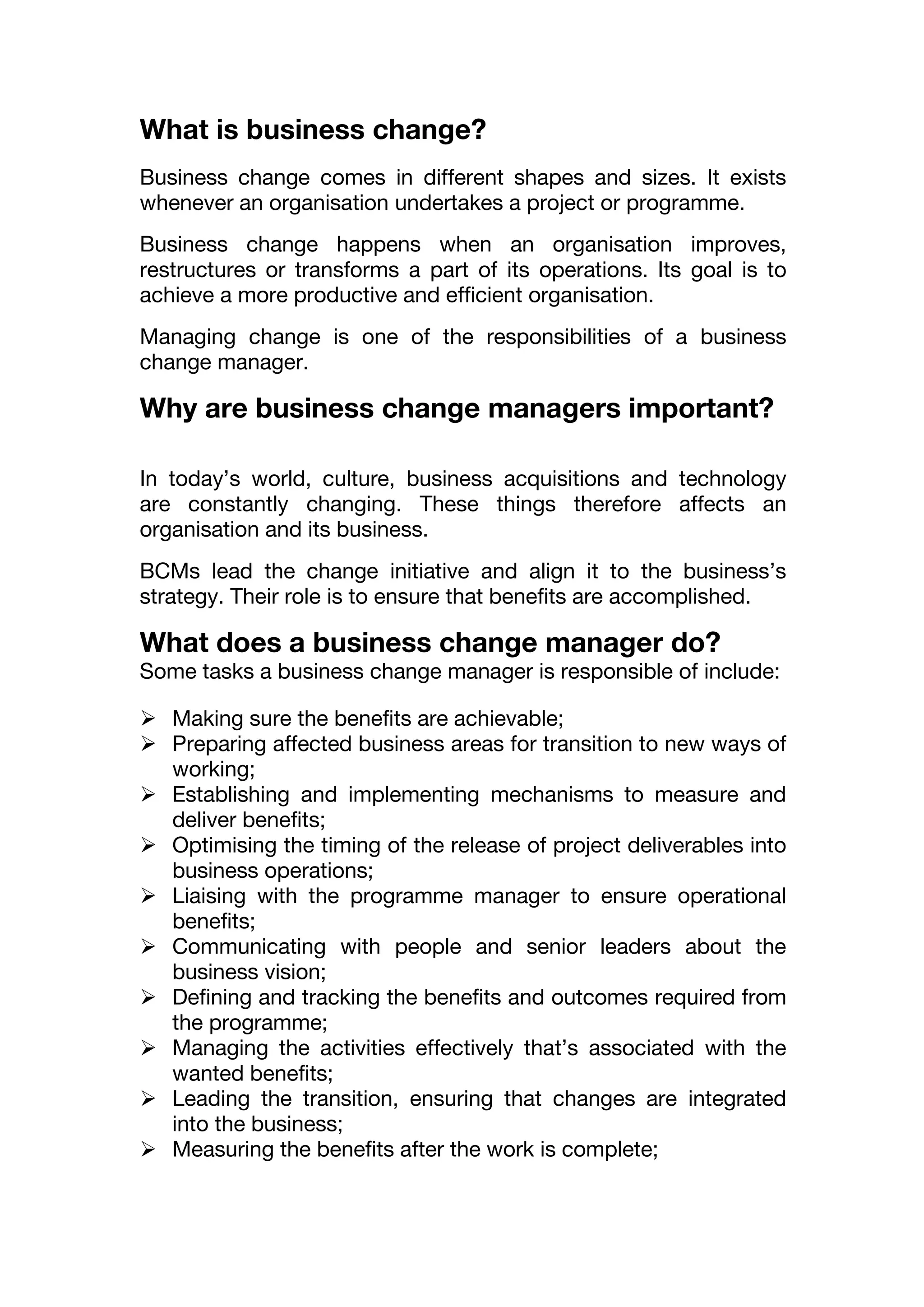


![Why organisations use change managers and
perform change management
Change managers play a significant role in the success of change
initiatives as they direct the desired outcomes down the right path.
They do this using best practices and customising such practices
to the organisation’s culture. Better performance from staff,
improved ways of working and higher sales targets are some of
the outcomes we can tangibly see.
Here are some findings after change management was
implemented in companies lead by a change manager:
According to IBM, the success rate of change projects using a
dedicated change manager rose by 19% compared to those
that did not.
ChangeFirst Limited say that six to nine months after project
launch, projects with change management input were
delivering significant performance improvements, financial
results and behavioural change. Most of the respondents
attributed over 20% of the success directly to effective change
management.
Ferris stated that effective change management delivers
improved adoption speed, utilization rate and employee
proficiency, stressing the importance of effective preparation
for change, disciplined management, and clear reinforcement.
Prosci mentioned that change management programmes rated
‘good’ or ‘excellent’ had an above-80% success rate. Those
rated ‘poor’ or ‘fair’ achieve less than 50%. [1]](https://image.slidesharecdn.com/changemanagementmodelsebook-210330094747/75/Change-management-models-ebook-16-2048.jpg)
![What a change manager does
A change manager manages the change portfolio. Some of their
responsibilities are:
Identifying, analysing and preparing risk mitigation tactics
Identifying and managing anticipated resistance
Integrating change management activities into a project plan
Evaluating and ensuring user readiness
They perform change management by:
Completing change management assessments
Defining and measuring success metrics and monitoring
change progress
Supporting organisational design and definition of roles and
responsibilities
Creating communications plan, sponsor roadmap, coaching
plan, training plan, resistance management plan
And other people involved are:
Stakeholders
Senior leaders, managers and supervisors
HR Personnel
Project leaders and teams
Other specialists related with the change plans [2]](https://image.slidesharecdn.com/changemanagementmodelsebook-210330094747/75/Change-management-models-ebook-17-2048.jpg)



![References
[1] The Change Management Institute (CMI) (2014). The Effective
Change Manager’s Handbook. Australia: Vivid Publishing. 4-5
[2] Prosci. (Unknown). Change Management Job Description.
Available: https://www.prosci.com/resources/articles/change-
management-job-description. Last accessed 22 Oct 2018.](https://image.slidesharecdn.com/changemanagementmodelsebook-210330094747/75/Change-management-models-ebook-21-2048.jpg)

